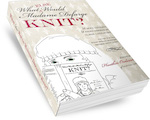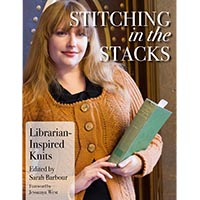Chapter 1.1—It Mattered Before
Sometime after 9/11 and our experiences at my high school, I started to hear rumblings from school counselors, therapists, occupational therapists, and—when I moved to Tucson, AZ—nurses.* The rumblings I heard went like this: oh, we used to teach that stuff, but that went out of vogue in the 80s.
Le sigh…
Of course, these rumblings were only coming from professionals *of a certain age* (ahem) and that, sadly, seemed to translate to: no one listens to them any more.
Which is a shame—because they know what you know.
This stuff, this knitting and crocheting and doodling, this stuff matters.
It matters to our souls, but more importantly,
in a world that likes to commodify everything,
it matters to our brains.
During and after World War I, knitting and sometimes spinning and weaving, were used as therapies for soldiers who suffered from shell shock. I’m of a mind that the reason this was such excellent therapy for these men is because of a few factors:
- yarn and fiber are soft, and soft is good after the hard, loud, aggressive battlefield;
- all of these activities are silent;
- all of these activities can be done communally or solitarily;
- all of these activities are (and I think this is particularly important) productive.
Especially when talking about men—and even more when talking about men of that generation—the ability to still be productive… at something… mattered. So it’s a scarf or a sock—who cares? It’s useful! And it could be used by the guys you left back at the Front.
And that mattered.
It still matters.
After 9/11 I, personally, went down a bizarre—but not necessarily surprising—rabbit hole. It took me ages to figure out what happened, but I understand it better now. It wasn’t just PTSD. That’s a given. It was PTSD coupled with uselessness. I didn’t want to go back to Ground Zero to witness. I wanted to go back to Ground Zero to help. When we were on the tip of Manhattan wondering how we would ever get home, there was a part of me—an embarrassingly large part of me considering what I was wearing—that wanted to head back North to help. To help any way I could.
I realized, duh, that the best way for me to help was to get my students home safely. But once that was achieved, I was looking for more, waiting for more. Waiting for our leaders to charge us with a task. Victory Gardens! Sox for Soldiers! Something.
It was only years later when I connected what I felt with what the soldiers in these archival pictures might have felt that the pieces fell into place.
The importance of having something to show for your time is important. It goes beyond my childhood “idle hands are the Devil’s playground” kind of training.** There’s a compulsion, some might say a particularly American compulsion, some might say a particularly ADD/ADHD compulsion (and some may say “what’s the difference?!”), but the compulsion to Not Waste Time, to Have Something To Show For Your Day, to Be Productive because Being Productive Leads to Fulfillment, that’s a motivating thing. And for men, particularly men who were raised as a generation to provide and be the stable center of their family life, to go through something like PTSD/Shell Shock… well that had to be Hell on many levels.
But there they are, knitting. A couple are even smiling.
Could have been crocheting, sure. I found pictures of knitters. Doesn’t matter. It’s sticks and strings and healing.
And that matters.
Next post this Friday, January 10, 2014
*This wasn’t a surprise. I joined the Tucson Handweavers and Spinners Guild and found that 90% of the members were former nurses. Okay, that’s an exaggeration, but it felt that way. The guild was awesome.
**Not that my upbringing was at all that sort. I just noticed that all the women in my family fidgeted, doodled, knit, crocheted, sewed, sketched, cooked… our hands—all of us—our hands were always busy. It was only later that I heard the phrase.
2 Comments















In addition to the productivity aspect of craft, I think that there is a deep satisfaction from working on something that has a beginning, a middle and and end–like a good story. I’m always puzzled by the oft-stated dichotomy in knitting (and other crafts) of process vs. product, as in “what kind of a crafter are you?.” You may attach to one or another on a conscious level, but I think both are there–and probably lots of other things that you will tell us in the book;)
I think you’re absolutely right. I think it’s why postal workers have *ahem* gone “postal” and why teachers get nuts in April. When there’s “no end” ahead, it can do bad things to you…. or be a sign of bad things going on (like Tita’s never-ending blanket of grief in “Like Water for Chocolate”.
I know the beginning, middle, and ending of projects is very settling for me.